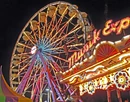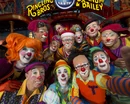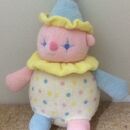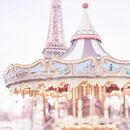Fanfare is an aesthetic surrounding circuses and carnivals, temporary events that involve spectacle, fun, and excitement because of their rarity, various rides and attractions, and interesting, sometimes mysterious people that operate the circus/carnival. Western culture has tropified imagery associated with circuses because of media and the traditions associated with going to these events.
These spectacles tend to be seen as outdated forms of entertainment with a folkish, almost tacky connotation. This is due to the fact that circuses were popular during the early to mid 20th century. Tradition has kept the visual imagery, with all of the events established during the Victorian era in P.T. Barnum's circuses. Past circus practices are also now seen as antiquated and abusive; lion-taming, seal clowns, and freak shows leaves a bad taste on modern audiences. They also are not as easily amused by clowns, "kiddie" rides, and live events, leading to decline.
Circuses may also have elements of fantasy. In fiction, it is not uncommon to have a circus be hiding the fact that the performers have actual magic powers that allow them to perform their stunts. So, the aesthetic can gain some mystique and elegance, with jewel-toned costumes, charismatic and flirtatious personalities, and an attractive form of danger.
Carnivals and circuses are two distinct types of spectacles, but have been associated with each other because they often overlap. Circuses put out rides in order to attract a wider audience and carnivals typically have stage shows that are the same as circus acts. Their temporary nature also forces them to use the same kinds of stands and tents as each other, and they also use the same type of imagery to bring excitement. Note that this aesthetic excludes amusement parks, water parks, and magic shows. Those are more permanent locations and have aesthetics that are more refined, put-together, and do not have the same visual tropes as fanfare.
Visuals
Circus acts and carnival attractions typically are seen as separate and evoke different emotions that are amplified with costumes, stage presence, and color scheme. In fanfare, all of these elements are combined, creating a varied yet cohesive aesthetic that utilizes this large range of different positive emotions to amplify the novelty associated with fanfare.
Performers
- Ring leader
- Elaborate costumes with top hats, coattails, and braided trim
- Clowns
- See Clowncore
- Trapeze artist
- Animal acts
- Bears
- Horses
- Lions
- Seals
- Tigers
- Strongmen
- Freak show
- Fortune teller and/or Spiritual Medium
- Costumes styled after stereotypes of Romani (G*psies)
- Crystal Balls
- Purple and gold tents
- Tarot Cards
Visual Tropes
- Striped Tents, especially red and white
- Pennant garlands
- Lightbulbs
- Fonts that are associated with vintage spectacle
- Hand-drawn posters
Food
- Candied apples
- Corndogs
- Cotton candy
- Funnel cake
- Popcorn
- Soft pretzels
Rides
Substyles
Dark/Creepy
Dark and creepy carnivals/circuses are one of the most popular interpretations of the genre. People like to subvert the cheerful elements and emphasize the mystery, occult, and distrust associated with the carnies. The vintage nature of these events also lead to a run-down and decaying appearance. In this dark interpretation, the performers are depicted as malicious or troubled. They may utilize their talents for evil, such as magicians keeping guests trapped to experiment their acts on or clowns being insane ax-murderers. Supernatural beings, such as ghosts, monsters, and vampires may be running the event, intent on eating, haunting, or torturing the guests.
Neon/Electric
Neon and electric aesthetics are a popular contemporary aesthetic of the funfair (it is the traditional format, not contemporary circus). Many modern carnies have decided to partly break away from the primary colors of their profession to renew interest in the public. Here, the tents and stands are neon and glow-in-the-dark. Space and alien imagery is popular, with shows that are free from the outdated attractions of before. Trapeze acts, arcades, and rides are more prominent, with the events only operating at night.
Pastel
Pastel fanfare emphasizes the daytime, vintage, and lighthearted elements. As the name suggests, the images are more pastel with antique Rococo details. The most popular attractions here are carousels, Ferris wheels, dancers, horses, and clowns. There are also illustrations and statues of performing seals and bears with cute hats and pastel accessories. Sweets such as cotton candy and strawberry desserts are one of the most common photographic subjects.
Media
Circus-themed fiction is one of the most popular ways of consuming the aesthetic and reinforces many of the emotions and visual tropes described above.
Anime
- Black Butler: The Book of Circus (2014)
- Kaleido Star (2003)
- Karneval (2013)
Books
Movies
- The Greatest Show on Earth (1952)
- The Greatest Showman (2017)
- Dumbo (1941) and (2019)
TV Shows
- Howdy Doody (1947)
- American Horror Story: Freak Show (2014)
Music
Circuses are often accompanied by a certain kind of music, often a cheerful, fast-paced march played by a big band. Brass instruments, drums, and the Calliope are the instruments that compose circus bands.[1] The most prominent composer is Henry Fillmore, who served as a circus bandmaster and composed many of the famous songs typically associated with circuses today.[2]
Specific songs have become associated with circuses because of their ubiquity, including:
Gallery




















